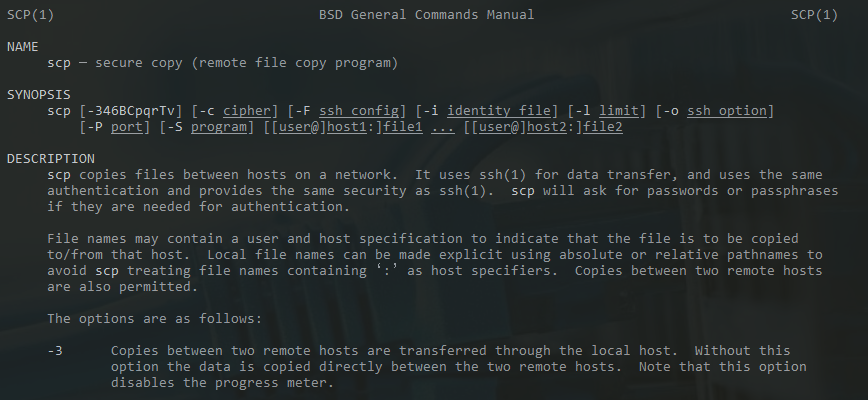A Comprehensive Guide to Using SCP for Secure File Transfer on Linux

A Comprehensive Guide to Using SCP for Secure File Transfer on Linux

Guide to Using SCP for Secure File Transfer
SCP (Secure Copy) is a command-line utility in Linux and other Unix-like operating systems that enables users to securely transfer files between hosts over a network. SCP is similar to the standard command-line utility cp, but it encrypts the data during transmission, providing enhanced security. SCP uses the SSH (Secure Shell) protocol to establish a secure connection between the source and destination hosts, and it supports authentication using a password or an SSH key pair.

How to use SCP to send data from host machine to remote machine?
To use SCP to transfer data from your host machine to a remote machine, follow these steps:
- Open a terminal on your host machine.
- Use the SCP command to specify the file or directory you want to transfer, the username and hostname of the remote machine, and the destination directory on the remote machine. The basic syntax of the command is as follows:
scp [options] /path/to/local/file username@hostname:/path/to/remote/directory
Example:
Transfer from My computer to Remote computer
Transfer file – scp ‘CONSULT Free Website Template – Free-CSS.com.zip’ [email protected]:/home/EIT/websites
Transfer Folder – scp -r My_folder [email protected]:/home/EIT/websites
For example, if you want to transfer a file named example.txt located in your Documents folder to a remote machine with the IP address 192.168.0.100 and the username user1, you would use the following command:
scp ~/Documents/example.txt [email protected]:/home/user1/
- Enter the password for the remote user account when prompted. If you have set up SSH key authentication, you may not be prompted for a password.
- Wait for the file to transfer. You will see progress information in the terminal.
How to use SCP to send data from remote machine to the host machine?
To use SCP to transfer the data from a remote machine to your host machine, follow these steps:
- Open a terminal on your host machine.
- Use the SCP command to specify the file or directory you want to transfer, the username and hostname of the remote machine, and the destination directory on your host machine. The basic syntax of the command is as follows:
scp [options] username@hostname:/path/to/remote/file /path/to/local/directory
Example:
Transfer from Remote computer to My Computer
Transfer file – scp [email protected]:/home/EIT/sites/timo.txt C:\Users\EIT-Sol\Documents\vm_share
Transfer folder – scp -r [email protected]:/home/EIT/sites/timo.txt C:\Users\EIT-Sol\Documents\vm_share
For example, if you want to transfer a file named example.txt located in the home directory of a remote machine with the IP address 192.168.0.100 and the username user1 to your Downloads folder, you would use the following command:
scp [email protected]:~/example.txt ~/Downloads/
- Enter the password for the remote user account when prompted. If you have set up SSH key authentication, you may not be prompted for a password.
- Wait for the file to transfer. You will see progress information in the terminal.
What are the options available for SCP commands?
SCP provides several options that you can use to customize the behavior of the command. Here are some common options for SCP commands:
Example:
Transfer file with SSH on different port – scp [email protected]:/home/EIT/sites/timo.txt C:\Users\EIT-Sol\Documents\vm_share -P 1300
Transfer file to machine with private Key – scp [email protected]:/home/EIT/sites/timo.txt C:\Users\EIT-Sol\Documents\vm_share -i /home/timo/keys/timo.PAK
- -r: This option enables SCP to copy entire directories recursively. It is useful when you want to transfer a directory and all its contents.
- -p: This option preserves the original file attributes such as permissions, timestamps, and ownership.
- -v: This option enables verbose mode and displays detailed information about the transfer process in the terminal.
- -C: This option compresses the data during transfer, which can improve transfer speeds over slow network connections.
- -P: This option specifies a custom port number to use for the SSH connection. By default, SCP uses port 22.
- -i: This option specifies the location of an SSH private key file to use for authentication instead of a password.
- -q: This option suppresses the progress information and displays only error messages.
- -l: This option limits the transfer speed to a specified rate in kilobits per second (kbps).
- -S: This option specifies a path to a program to use as an alternative Secure Shell (SSH) implementation.
- -F: This option specifies a custom SSH configuration file to use for the connection.
These are some of the commonly used options for SCP commands. You can view the full list of options and their descriptions by typing man scp in a terminal on a Linux or Unix-based system.
Conclusion
SCP is a powerful tool for securely transferring files between hosts on a network. With SCP, you can easily transfer files and directories between your local machine and a remote machine, or between two remote machines. By using SCP with SSH, you can ensure that your data is transmitted securely and encrypted, protecting it from prying eyes. The options available for SCP commands provide a great deal of flexibility and control over the transfer process. By mastering SCP, you can efficiently and securely move data between hosts on your network.
Guide to Using SCP for Secure File Transfer



